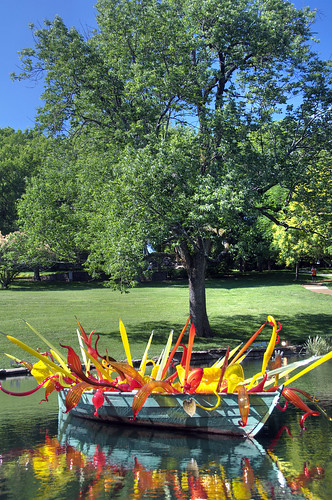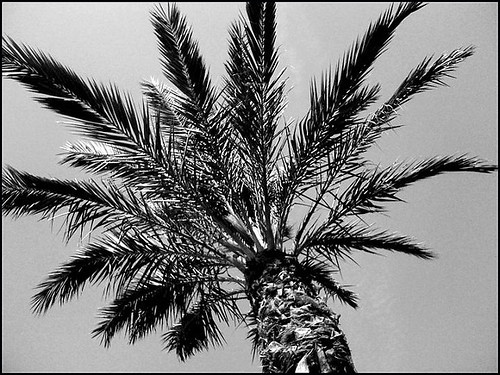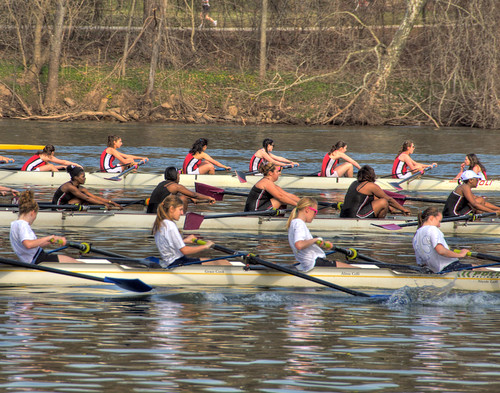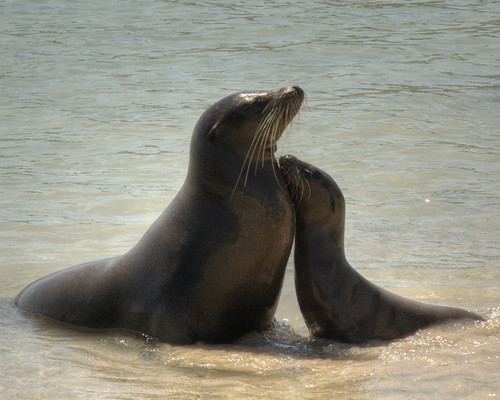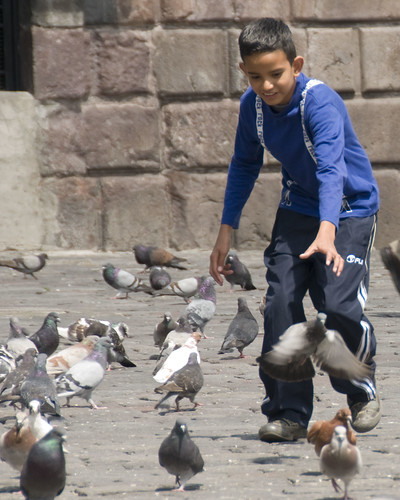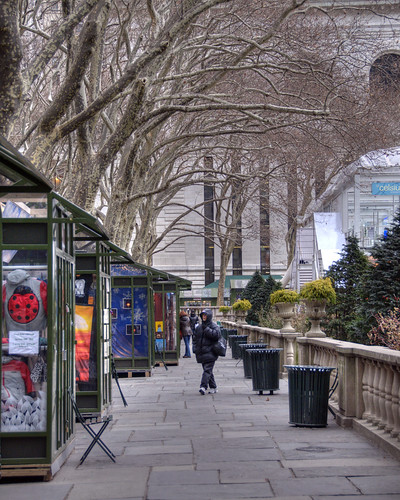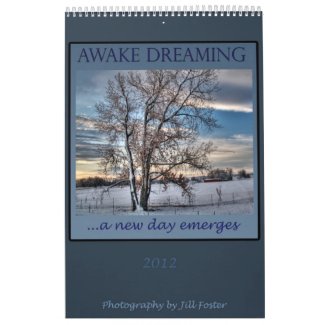This photo, an infrared HDR shot of the Mississippi Monument in Gettysburg National Historic Battlefield Park blends a variety of techniques. First, it was shot with an infrared converted Nikon D70 so that they only light hitting the sensor is in the infrared spectrum. That gives the white grass and leaves and the enhanced darkness of the monument stone. The cottony quality of the sky reflects early morning with a combination of low sun and the fog not totally lifted.
The second technique is HDR with 3 shots taken: one overexposed to bring out the features in the statue and the house that was in the shade, one normally exposed, and one underexposed to bring out the texture in the sky. I used a tripod to keep all of the images aligned. combined the images in Photomatix, and did more work in Photoshop for the final effect. They were shot at f/16 with shutter speeds of 1/40, 1/80, and 1/160 respectively at an ISO of 400.
Wednesday, July 28, 2010
Blending Techniques
Monday, July 12, 2010
Add dimension, find an interesting angle...

When shooting during travel photography, there's a natural inclination to try to document what you have seen by lining up right in front of it and clicking the shutter. Voila, an image that anyone could have captured and one that is immediately recognizable to someone casually walking by. Ironically, though, by documenting you may not be informing. Try finding a more interesting angle, from above, below, obliquely, etc. In these two images, both of the same barn near Norwich, NY, the first one is a straight on shot, but the second, I think, is a more interesting angle and shows much more depth. Photographers have the option of going for a higher angle (use a ladder, climb a tree) or lower (lie on the ground). In this case, I was lucky and just walked down the small hill leading up to the barn. Remember, with any shot, you make choices about what to include and what to exclude (in this case, by choosing this angle, you lose the silo).
Both of these photos were shot with a Nikon D300, f11. 1/125 sec and 1/160 sec respectively, ASO 400 with a wide angle lens, 18 mm and 27 mm respectively. The images were then processed in Photomatix for an HDR effect. The bright sunlight and interesting clouds were luck.
Wednesday, June 9, 2010
If You Find Yourself in Nashville...
This summer at the Cheekwood Botanical Gardens in Nashville, Tennessee, the landscapes have been transformed with environmental art-- floating in the pond, erupting from the ground like plants, scattered along the landscape, replacing the water in fountains. The Gardens, even without the blown glass is beautiful, but the addition of Dale Chihuly's art really makes for a special trip. On Thursday and Friday nights, the glass is illuminated. "Chihuly at Cheekwood" is on display through the end of October. Visit Nashville if you can, they are really struggling after the recent flood.
Monday, May 31, 2010
Textures
When composing a photo, consider how different textures might add interest to the photo. In this photo, Seaside, taken in the pool area of the Gallows Point complex in Cruz Bay, St. John, US Virgin Islands, there are a variety of textures. There is the smoothness of the palms and the cotton candy sky, the shiny metal of the chairs, the backs of the chairs that are semi-transparent so that you can see yet another texture behind it, and the choppy texture of the water (both of the ocean beyond and of the small area of pool in the foreground).
This photo was taken with an infrared converted Nikon D70, mounted on a tripod to get the maximal depth of field, f 18 and a shutter speed of 1/80 sec. The image was then processed in Photomatix to givea high dynamic range (HDR) image to mimimize the differences in lighting in the various areas of the shot.
Monday, May 24, 2010
Swim With the Fishes
Swim with the Fishes, originally uploaded by Cocoabiscuit.
Somehow, still images just didn't capture the rhythm of this school of fish as they swam along the reef.
These photos were taken with an Olympus Tough, a point and shoot camera for up to 15 feet deep. I took a combination of still and video and unfortunately left the power cable home, so these will be the only pictures from this camera. Luckily I have a back up camera assuming there are no more equipment malfunctions (or packing malfunctions rather).
I'm still working on figuring out how to best take underwater pictures, so stay tuned.
Saturday, May 22, 2010
Worth the mosquito bites?
Often times there's a moment when the rest of the world fades away. This moment with the sun setting behind this gazebo was so ethereal that I unfortunately did not notice the swarm of mosquitos that had landed on my legs. Oh well, it was worth it.
This shot, Gallows Gazebo was taken at Gallows Point on St. John, US Virgin Islands. The view is looking over Cruz Bay at the British Virgin Islands.
I shot it on manual settings of 1/6 sec, f10, ISO 400 (on a tripod) with my Nikon D300. Then I processed it with a little bit of HDR in Photomatix to bring out the colors of the sunset but also still have some detail in the gazebo.
Thursday, April 22, 2010
Patience is a Virtue
This shot, Happy Landings, of a hummingbird, took approximately 40 shots to get one good one. For most of the snaps, the hummingbird was either out of the frame, the wings looked funny, or was at an angle that wasn't quite right. Luckily, I had the leisure to just stand in one place for a while, shooting when it seemed right, moving to another spot to do a few more, etc.
To set up the shot, I knew I wanted a fast shutter speed (1/500) to best capture him. Faster than this, I probably wouldn't have had enough light in this spot under the umbrella of tree leaves and I wouldn't have been able to "stop" him but still get a sense of motion in the wings. I wanted to blur the background, because the hummingbird was the main event, not the leaves behind him, so I used a large aperture (f 5.6). I let the camera choose the ISO, 3200 in this case. I used the maximum zoom on my lens of 200 mm and used a 1.4x teleconverter. I would have liked to have been closer, but I seemed to scare them away at closer distances.
I shot this at the Boyce-Thompson Arboretum, Superior, Arizona (about an hour northeast of Phoenix). It's part of the Arizona State Park System and the University of Arizona.
Want some hummingbird trivia? They are among the smallest of birds and the only ones that can fly backwards. Like bees they get nectar from flowers, but need to eat insects to get enough protein. They have the highest metabolism of all animals and their heart rate is 1250 beats per minute and their wings beat about 3,000 times per minute. Their nests are held together with spider silk and although most don't make it past the first year, they can live up to a decade.
Friday, April 9, 2010
The oddest national park site I've ever been to...
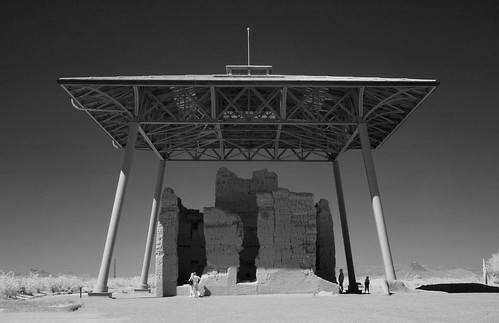
Alien Landing?, originally uploaded by Cocoabiscuit.
Casa Grande National Monument* is what's left of the ruins of a Hohokam village from about the 14th century. It is rumored to be the largest prehistoric (our history at least) building in North America. "Discovered" by Spanish explorers in the late 17th century and again by American archeologists in the late 19th century. Graffiti from several centuries of adventurers is carved on its walls (and it is now illegal to add your signature). In 1932, someone decided that it needed a roof to protect it from the elements, despite having survived 7 centuries without one. The roof is termed a "Ramada" and was built by the Civilian Construction Corps. It sits on a one mile square parcel of land set aside by presidential decree in the town of Coolidge, Arizona. (The town of Casa Grande is some miles east.) The structure is visible from miles as you approach the town.
This shot was with a Nikon D70, converted for infrared, f16, 1/320 sec, 45 mm.
*National parks are by act of Congress, while national monuments are by presidential executive order.
Saturday, March 27, 2010
The Best Camera is the Camera that You Have
Sometimes you find something nice, but don't have your camera with you. Most people have a camera in your phone these days, but then what to do with it? If you have an iPhone, it's easier and there are a number of apps that can help you to process the photo to fix it up a bit before using it or posting it. In this photo, I used "The Best Camera" app which has quick "fixes" with filters with cool names such as "Paris" that I used with this photo, "Jewel", "Candy", etc. To get more typical photo processing tools such as cropping, color and exposure adjustments, etc. I use "Photogene". Contrary to the hundreds of dollars you'll spend on Photoshop, these apps are <$5.
This photo is of a palm tree in Orlando that I took. I'm attending a conference and took a lunch time stroll outside. My first thought was "I wish I had a camera, the light is so wonderful" and then luckily I remembered the iPhone in my pocket.
Sunday, March 21, 2010
A Beautiful Day in the Neighborhood
With unexpectedly good weather for the weekend after a punishing winter, it was time to head to Kelly Drive. I was thwarted in planning to go to the Art Museum grounds by a regatta, so decided to go with it and photograph it instead. It was challenging because the background was more typical of late winter, but the action was all spring/summer.
Settings: f11, 1/250 sec, 200mmSunday, March 14, 2010
The Value of Getting Close - Zooms and Teleconverters

Galapágos Tortoise originally uploaded by Cocoabiscuit. Using a zoom or walking close to the item being photographed really works out. The subject of interest is the tortoise, not the background, which was just a dirty enclosure filled with other very similar tortoises. By getting close, you get a much better picture of the textures and colors.
Because getting inside the pen with the tortoises was really discouraged by the folks at the Darwin Research Center (Santa Cruz Island, the Galapágos), I used 3 ways to get closer. The low tech way was to lean as far over the fence as possible. The rest was optical: a zoom lens, in this case a Nikkor 18-20 VR and then to get even closer a teleconverter. I bought a Kenko N-AF 1.4X teleconverter specifically for this trip. It snaps on between the regular lens and the body of the camera. It extends the maximum zoom of the regular lens (200mm) to 340mm. Caveats are that because it is essentially putting a magnifying glass in front of your camera body, it also magnifies light and I had to use exposure control of about 1.5 to compensate and the exif data for the camera won't reflect the increased zoom.
Wednesday, February 24, 2010
Diego, the Stud Muffin Tortoise

Diego is a Galapagos Tortoise at the Charles Darwin Research Center in Puerto Ayora on the island of Santa Cruz in the Galapagos, Ecuador. The Galapagos Tortoise is the world's largest tortoise and lives only on the Galapagos (and in zoos). Initially numbering over 200,000 when the islands were "discovered" by traders and pirates, they are now endangered and some of the sub-species are extinct. Sailors from passing ships would take the tortoises to use as food. Tortoises could survive for up to a year without food or water, so they were stacked in the hold of the ship to be used as needed for food. Another reason for the decline in their numbers is the introduction of non-native animals which steal and eat their eggs.
The Darwin center has a breeding program in an attempt to increase the success of turtles hatching from eggs. The baby turtles are then re-introduced to the islands where they belong. "Lonesome George" the most famous of the Galapagos tortoises, is the last of the tortoises from Pinto Island showed no inclination to reproduce. Diego was one of the 15 remaining tortoises from Espanola and was located at the San Diego zoo. He was brought in to service female tortoises-- and has single handedly contributed to ensuring that the Espanola tortoises will not become extinct.
This photo is an infrared photo taken with my IR converted Nikon D70, f 4.5, 1/125 sec, 105 mm. The lighting was challenging because it was early morning and foggy.
Thursday, February 18, 2010
Diabillos
In Ecuador, instead of mardi gras, they celebrate a hybrid of Catholic and Huarangas traditions. What results is a four day weekend celebration where families go to the beach and in small villages, children referred to a diabillos or little devils chase each other with water. In the original huarangas tradition, people throw water and flowers were tossed to show admiration, but the updated version is more about water balloons and shaving cream. Older teens drove to a nearby river and filled large tubs of water which they would then douse people with from the backs of pickup trucks.
I shot this photo from inside a car (with closed windows) in a small town, Cotacachi,as we drove by these two girls and the youngest one was trying to decide whether or not to spray us with shaving cream. Settings were f 6.0, 1/640 sec, 60 mm, ISO 400. Because I was shooting through a car window, I cleaned it up in Photoshop.
Friday, February 12, 2010
Trying Something New
Today, I combined two things I love-- swimming and photography to a good effect. Yesterday, I learned to snorkel and was dying to take my camera but decided I should work on the breathing through a tube and navigating through the water first. Today, I tried out a point and shoot camera, the Olympus 550WP designed to be waterproof up to 10 feet down that I got on clearance mostly to have something take out in when it's raining. It seems to have worked. This set of photos is from underwater off Santa Cruz Island in the Galapagos and are of schools of angelfish which were everywhere. There was also a shark sleeping in a cave that it was too dark to photograph and I didn't want to wake him up with flash. The guide assured us that he was harmless, but I didn't want to push it.
The camera does everything automatically, even has a "underwater" settings, so the camera did all the work of calculating exposure of f 1.3, 1/60 sec. The conditions weren't optimal because there wasn't much sun and the images were washed out looking, so I cleaned them up in Photoshop.
Thursday, February 11, 2010
Capturing a Moment in Time
Sometimes, you just get lucky-- you witness an incredible scene and have a camera in your hand. Today, we set out by boat for a 2 hour ride from the main island of the Galapagos, Santa Cruz, to the island of Santa Fe. The entire island is a national park. We spent some time on the beach watching the Galapagos sea lions that are everywhere and very friendly. There are no predators here for most of the animals, so they don't show any fear despite people wandering around them snapping their pictures. There were newborn sea lions (pups) nestled in the rocks and this slightly older one was trying to get the mother to lie still so he could nurse. He won and she started nursing him a few minutes later.
We then went back to the boat and donned snorkeling gear and then went swimming with them. Underwater, they would swim right up to you and then quickly turn after being only inches from your face. I think they were fascinated by the mask.(The difference between sea lions and seals is that sea lions have ears.)
There was nothing very complicated about the photography today-- lots of sun, so could shoot at a fast shutter speed and have a reasonable depth of field. This photo was shot at f 18, 1/250th of a second, 180mm (using a teleconverter). Tomorrow, I'm going to try underwater photography now that I have the basic of snorkeling figured out.
Tuesday, February 9, 2010
The Chase
Balancing aperture (f stop) and shutter speed can be tricky. Shutter speed stops the action (or conversely slows water down to make it look more velvety). Aperture determines how much of the scene is in focus-- narrow depth of field will have sharp focus on one plane of the scene with the rest blurry while a wide depth of field keeps everything in focus. F stop is represented as a reciprocal, so a high number (16) is 1/16th of the shutter open and provides everything in focus, while a low number (4.5) is 1/4th of the shutter open and therefore spreads the image of a wider area of the lens and makes only a small amount in focus. The more light available, the higher number f stop you can use and therefore have more options for choosing depth of field.
In this shot, "The Chase", I wanted to stop the action of this Ecuadoran boy reaching for the birds in the Plaza San Francisco. I also wanted to keep him, the birds, and the wall behind him in focus. Because it was fairly sunny, I had good light I chose depth of field f 13 and sacrificed a little bit of motion with a shutter speed of only 1/200th of a second. I stopped the boy's motion, but not the pigeons'.
Monday, February 8, 2010
It's all about perspective...
One could view having ones vacation delayed and foreshortened by a day by snowmageddon or one could view this as an opportunity to visit Miami and wait there for the next available flight to Ecuador-- and live vicariously through all the elated Saints fans who are everywhere. This isn't the worst option and now we're finally on our way for the last leg of the trip.
This shot, Flight Delay, shows more about relative sizes and composition. One knows that the plane is bigger than a palm tree, but in this shot, the plane almost looks like a toy. Having the tree cover a portion of the plan tells the eye that the plane is behind the tree and at some distance in the background.
Infrared photo from a Nikon D70, f 10, 1/400 sec at 66 mm, ISO 200.
Monday, January 18, 2010
Using Wide Angle Lenses

This image, Rocketship to God, is a good example of the result of using a wide angle lens, i.e. a low number of mm. Your eye gives you a panoramic view of your scene, but the camera lens/sensor is only able to capture a small portion. If you zoom in , you get a close up view as if you were walking toward the object. Zooming out (as if you were getting father away) is more complicated optically. Because you are not truly getting father away, the lens compensates, but does this with distortion so that the items in the edge curve towards the center. To measure the amount of distortion, draw lines on each edge that should theoretically be parallel (rectilinear) and you will see that they converge (called barrel distortion).
In this photograph of the St. Louis Cathedral in Jackson Square, New Orleans, it appears that the spires have rotated inward. The large object combined with how close I was and by me shooting upward emphasizes the wide angle effect. While this can give a dramatic effect, it doesn't always work well with all scenes. Be especially wary of using wide angles when photographing someone's face. With most digital SLR cameras, using a focal length of anything lower than 42 mm will give some barrel distortion.
This photo was shot at 18mm at 1/320 sec, f18 with a Nikon D300 and Nikkor 18-200mm zoom lens.
Thursday, January 14, 2010
Composition - Choosing What to Put In and What to Leave Out
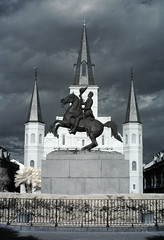
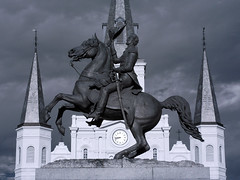

In this series of photos of the statue of Andrew Jackson in Jackson Square, New Orleans all of the photos are of the same thing, but are very different. Before clicking the shutter, the photographer needs to make a decision of what the photo is about. Is it to give a landscape view of the park or might someone be more interested in a close-up view of the statue. For someone who has never been to the Square, looking at the close-up view wouldn't be very satisfying in getting a picture of what the square looks like. For someone who really doesn't care about the square, but is an afficianado of "Old Hickory" (Andrew Jackson), the close-up view is going to be more interesting.
You can also see by these three shots, that even though they are of the same thing with the same lighting and camera, there is a very different feeling in each. Placing an object in relation to other objects can sometimes inform about relative size (as in the top view) or be distorting as in the middle view where the statue looks almost as large as the St. Louis Cathedral.
Even though you're shooting digital and don't have to worry about "wasting" film, take some time before you click the shutter. Walk around the area and view the scene from different angles to see where the best light is, assess the whole scene, and think about what story you want to tell.
The top photo, Jackson Square, 1/320, f14, 32 mm, and the middle is Place D'Armes,and bottom Old Hickory are 1/250, f13, 52 mm. All 3 photos shot with an infrared converted Nikon D70.
Monday, January 11, 2010
Compare and Contrast - Infrared HDR and Color HDR

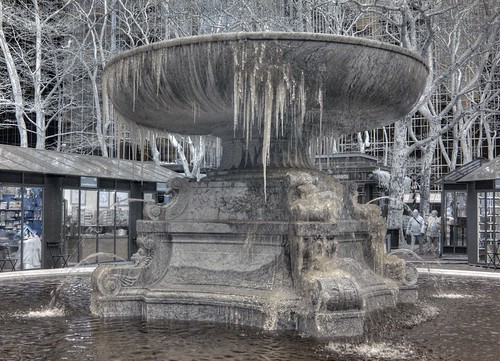
Both of these shots were taken at about the same time of the same fountain in Bryant Park, New York City. Both are processed as HDR from one raw shot (see this blog). In the bottom shot, taken with an infrared converted Nikon D70, an infrared filter blocks out most light other than in the infrared spectrum, giving the surreal quality to the ice/water and providing greater contrast. In the top shot, the full spectrum of color is seen (minus infrared since most digital cameras are fairly insensitive to infrared light).
Both shots were processed in Photomatix and Photoshop CS4. The top shot is 1/80 sec, f 7.0 28 mm, ISO 400 and the bottom shot is 1/150 sec, f 4.0, 29 mm, ISO 400.
Sunday, January 3, 2010
January Morning
Sometimes it's the simple things in life. To the left of this shot is a busy street with cabs rushing by and to the right is a skating rink packed with skaters. In between, is a quiet walk among the mostly closed kiosks in Bryant Park in New York City-- kind of a serenity sandwich. And yes, it was as cold as it looks. It was in the teens with the wind chill and most of the water in a fountain nearby had turned to ice.
(1/250 sec, f 4.5, ISO 400, 52mm processed first in Photomatix with HDR generated from a single raw and then in Photoshop)
Saturday, January 2, 2010
Attention to Backgrounds
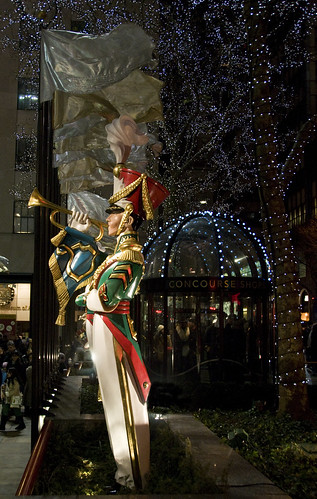
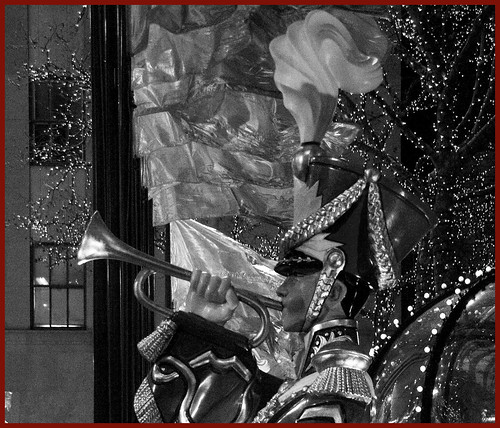
In these photos, having a busy background works out by giving the appearance that the showers of light are coming out of the trumpet (instead of from lights in a tree behind the figure). Sometimes, this doesn't work out so well when it can look like a statue is coming out of someones head or a tree branch out of someones ear. Framing a shot in photography should include not only what you want in your photo, but also what you want to exclude and how you want to line your main subject up in relation to background objects.
These photos are from Rockefeller Center in New York. The bottom, Hark the Herald was shot in color and converted to black and white to highlight the interplay between light and dark. The exposure settings were 1/80 sec, f 4.0, ISO 1600 at 38mm zoom. In the top one, Trumpet Shower of Light, color becomes more of the story. It was shot with similar settings to the first.


